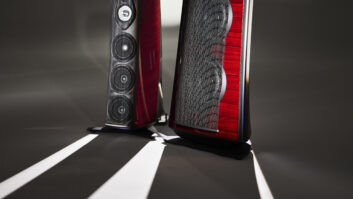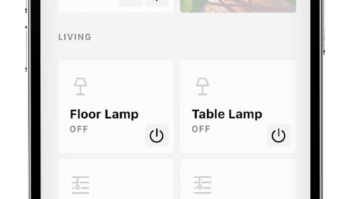When it comes to high-end home technology, nothing matches the “wow” power of a premium home theater. In recent years, projection technology has accelerated so rapidly that it has become possible to achieve a level of cinematic brilliance in a private residence that can rival that of the finest commercial theaters. In addition to this enhanced quality, projectors have gained a ton of versatility, and are now commonly replacing flat panels in a variety of multipurpose settings.
All of the tireless engineering work behind the plethora of new projectors would be for naught, however, if it weren’t for the equally ambitious efforts on the other side of the lens: the projection screen. While not as immediately obvious to the uninitiated, the right screen materials for the application can not only transform a dull, muddy image into one that pops with vividness, but also allow projection to be used in places unimaginable just a few years ago.

Da-Lite’s Parallax screens feature sophisticated ALR technology that still permits a wide viewing angle.
One of the most logical recent advancements in screen technology reflects one of the biggest trends in video: UHD/4K. With quadruple the video detail, screen materials need to be that much more precise, as well. “There is a great expansion of projectors offering 4K resolution,” said Vijita U.G., marketing manager at Stewart Filmscreen. “When a 2K image is blown up too much, it exposes the pixel structure and can make the image grainy. For Stewart, with all its screens rated 4K-plus, having higher resolution light engines enables larger screens while maintaining immaculate film-like quality. This is all the beneficial result of the greater pixel density.”
Robert J. Grawet, president and CEO of Grandview Screens, also stressed the importance of screen quality being up to the task of displaying the highest resolution imagery available, and offered a solution in the form of its Reference Series Screen. “For anyone who hasn’t paid attention, the image that is being projected by these new 4K and 8K projectors provides such fine detail at the screen, you must match them with a textureless screen surface to provide the ultimate detail available,” he said. “You can make your picture as big as your room will allow, add that awesome projector and a ‘textureless screen surface,’ with ISF [Imaging Science Foundation] certification, and your friends and neighbors will never go home after seeing a movie or football game at your home.”

Seymour-Screens Excellence’s ambient light-rejecting (ALR) technology features billions of nano-mirrors dithered at the desired viewing angle, and layered so that side light gets absorbed by carbon particles and the substrate.
Indeed, two-piece projection is now very commonplace outside of the dedicated theater, and there are few better applications for big-screen entertainment than watching football and other sports. But football games, in particular, have been tricky events to accommodate: most of the games are played during daylight hours, and nobody wants to sit in a dark room all day. Luckily, screen manufacturers have made giant leaps forward in ambient light-rejecting technology, allowing for a brilliant, clear picture to be projected in even the brightest of rooms.
Companies like Seymour-Screen Excellence have re-examined the reflective properties of screen surfaces to engineer surfaces that only reflect light that hits the screen head-on, preventing ambient light from diluting a projected image’s brightness. “In its mission to develop a ‘better breed’ of ambient light-rejecting (ALR) film screens, Seymour- Screen Excellence created a unique (proprietary) surface that solves the many issues that have plagued ALR film screens to date: namely color shift, sparkles, and ringing,” said Paul Muto, the company’s public relations representative. “The Ambient-Visionaire surface is unique in that it’s comprised of billions of nano-mirrors, dithered at the desired viewing angle, and layered so that side light (from any direction) gets absorbed by carbon particles and the substrate.” According to Muto, the company’s Black 1.2 ALR screen absorbs 90 percent of ambient light, enabling 12 times greater contrast ratios in bright environments.

Elite Screens’ Ceiling Light-Rejecting models reject 95 percent of the washout effects of ambient lighting from overhead sources, according to the company.
Elite Screens also has been innovating the category of ALR screens, helping the two-piece projection category to edge into the multipurpose room segment that’s still largely dominated by flat panels. And one of the biggest technologies driving that market infiltration is the short-throw category. “A new subcategory of ALR is the Ceiling Light Rejecting (CLR) material that can actually be used with short-throw projectors,” said David Rodgers, marketing manager, Elite Screens. “Now, a large projection display doesn’t even suffer from dynamic shadow effect caused when someone walks between the projector and screen.” Elite’s Aeon CLR model is an edge-free, fixed-frame screen with specialized short-throw material that rejects 95 percent of the washout effects of ambient lighting from overhead sources, according to the company.
Despite rejecting incoming light from the sides of the screen, today’s ALR screens are still able to display images that can be viewed clearly from nearly any angle, a core characteristic of Da- Lite’s Parallax and Parallax Thin models. “With extremely wide viewing angles as standard, the audience can see the same quality of image sitting directly on axis to the image or well off to the side,” said Rhen Taylor, associate product manager, Da-Lite. “The ambient light-rejection technology of Parallax is also speckle free, which is critically important when pairing with the newest laser projectors that are in the market.”

Stewart’s LuminEsse screens feature an “edgeless” design, delivering the sleek aesthetics with optional LED backlighting for a striking visual presentation.
For the high-end client, however, capability is not enough of a factor when it comes to replacing flat panels in certain areas of the home; aesthetics are integral to the decision, as well. Well aware of the tastes of discerning customers, screen manufacturers have been adapting their product selections to make two-piece projection an attractive addition to nearly any environment. “The latest projector technology has opened doors to new, contemporary screen types such as Thin Bezel and Zero Edge screens, giving the homeowner the feel and appearance of an extremely large flat-screen TV at a fraction of the cost,” said Aaron White, Severtson Screens national sales director. “These visuals, coupled with the latest advancements in acoustically transparent screens are providing consumers with new and exciting options.”
Screen Innovations has taken the popular aesthetics of the small- or no-bezel projection screen and added additional versatility, allowing them to be located in places where a projection system would otherwise interfere with a room’s décor. “When we released Black Diamond and Zero Edge, we made the screen look cool in any environment, and hold its contrast even in the worst lighting environments,” said Skyler Meek, director of marketing at Screen Innovations. “That, however, was still not enough because the screen was always there. The same is true for flat panel; you can’t roll up and store away a flat panel screen. Even with motorized screens, you can drop them down in front of a wall or bay of windows, but even the top of the line motorized screens still have to be tensioned by a tab system and suspended by a large black matte.” The company will soon be releasing a solution for this problem, an “all-new take on motorized projection screens, which eliminates that unsightly and unnecessary ‘bat wing’ above the screen surface–allowing you to enjoy your viewing experience in an unobtrusive way,” Meek said.

Vutec’s Theater Art Systems transform from gallery-worthy framed art to a theater-worthy projection screen with the push of a button.
For certain clients’ rooms, however, a completely different aesthetic is desired–not one that aspires to be futuristic, but rather the opposite: a genteel solution that would feel at home in a lavish portrait gallery. For these clients, Vutec’s Theater Art Systems are the answer. “Fine art, stylishly framed, becomes the focal point of a great room. At a push of a button the great room transforms into a ‘great theater,’” said Darius McDougle, executive director of marketing and design at Vutec. “The finely decorated art ascends to reveal Vutec’s flagship, patented SilverStar projection screen surface.” The company’s screens come with a variety of choices for artwork, which retracts into elegant frames to expose the projection surface, enabling screens to be located in rooms where even flat panels would look out of place.
Perhaps the boldest frontier-pushing development of all, the exceptionally high-lumen outputs of today’s projectors coupled with the newest ALR screen technologies have enabled projection to go to the most unthinkable location possible: outdoors. “While light control is always ideal, Draper has surfaces available that deal with ambient light and deliver a stellar picture. People are getting more and more creative with screen placement,” said Amy Madden, residential market manager for Draper. “That leads me to our Nocturne screen. It allows you to take your video outside and make it BIG–up to 120 inches wide in any format. Designed for alfresco use with a weather- and insect-resistant headbox, along with cable guides and a weighted dowel for maximum stability in breezy situations.”

Screen Innovations has a variety of stylish offerings “to make the screen look cool in any setting.”

Draper’s Nocturne model screens are designed to be used outdoors, with features such as a weatherand insect-resistant headbox.
With the continued development of projection and screen technology, the options for providing the best entertainment experience possible continue to grow. After all, movies–and increasingly TV shows and video games–need to be viewed on a larger-than-life screen to truly capture the full sense of wonderment that these sophisticated productions convey. Now, you can take the experience of studio magic out of the theater and put it just about anywhere–and do it with style.
Matt Pruznick is associate editor of Residential Systems and Systems Contractor News. Follow him on Twitter @Pruznick.







